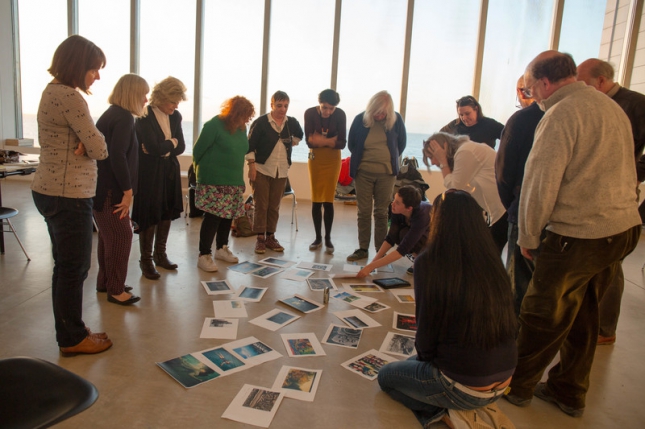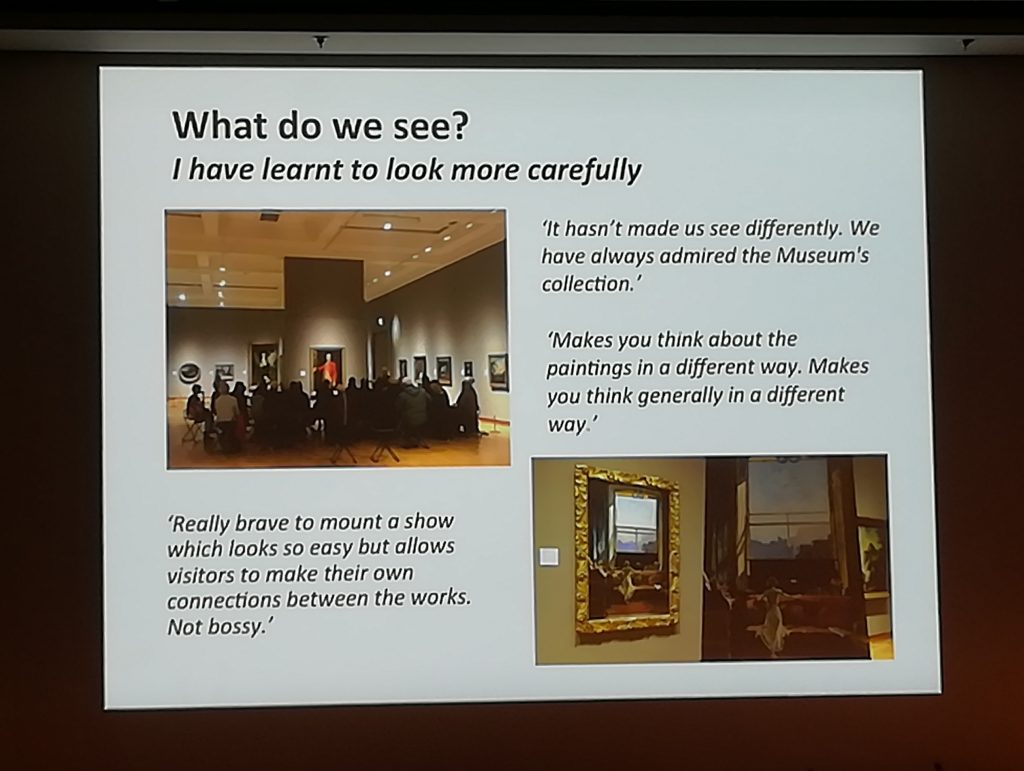Does one style fit all? by Elizabeth Socci

1) Photograph of Turner Contemporary’s research group for their Journeys with ‘The Waste Land’ exhibition, https://www.turnercontemporary.org/exhibitions/journeys-with-the-waste-land
I had been looking forward to this conference for many months and it certainly didn’t disappoint. As someone who is in the early stages of their curatorial career, working at a museum which is going through a large-scale expansion project and rethinking of art curation, I knew this conference would be beneficial.
To give you an insight into our fine art collection at Northampton Museums & Art Gallery – it is predominantly made up of traditional, pre-twentieth century works of art, but we also have a substantial collection by local artists, and several modern works as well. Additionally, we have a vast collection of decorative art. The majority of both these collections are rarely on display due to limited gallery space. It is therefore challenging not only to make it accessible, but also relatable for our audiences. Nevertheless, the wealth of genres, artistic periods, countries, and styles represented within our collection is exciting and full of opportunities for potential displays.
Our intention for the art collection, once the museum reopens, is to have a regularly changing programme of temporary exhibitions across our two art gallery spaces. These will focus on different themes, subjects and artists represented in our collections, supported by a range of interpretation, interactives, and events. The hope is that through this we will showcase a wider range of our collection while reaching and appealing to a wider range of visitors.
Coming to the conference one of my biggest questions was – is there one approach to exhibiting art that is best, that will suit all collections or museums? Can one style fit all? After listening to the diverse range of talks, I was pleasantly reassured to find that different approaches suit different museums. Thus, our intention for temporary exhibitions seems the best for our situation. However, there were also wider exhibition concepts that I hadn’t fully considered before, and these are what I want to discuss further.
These key concepts are co-curation, audience involvement and evaluation. Although I took onboard ideas from many of the speakers, I will just mention some key points from three talks. Dr Ellen McAdam talked about temporary exhibitions and (like several speakers) encouraged audience research and listening to our visitors. She also mentioned how the process and conversations involved in co-curation are just as important as the final exhibition. Additionally, she highlighted how new interpretation and exhibition styles can put off traditional visitors. Thus, I understand how a carefully tailored approach to interpretation and audience involvement is crucial when developing an exhibition programme.

1) Photograph of Turner Contemporary’s research group for their Journeys with ‘The Waste Land’ exhibition, https://www.turnercontemporary.org/exhibitions/journeys-with-the-waste-land
Emma Ridgway’s discussion on exhibition curation was inspiring as well as challenging to me, and probably many curators. She questioned if we are avoiding experimentation, particularly when it comes to opportunities for co-curation? The project and exhibition that she talked about at Turner Contemporary is certainly intriguing, and it was great to see the diverse range of people involved and the mix of audiences who are visiting it. This talk made me realise the value of audience involvement. Giving our visitors a sense of ownership and place in the gallery is so important and something that I want to consider more in our exhibition planning. Equally it is certainly an exhibition I want to visit and one that I may not have come across if it wasn’t for Emma’s talk.

‘What do we see?’ slide from Ulster Museum’s presentation, photograph taken by Elizabeth Socci at ‘Why Exhibitions?’ Conference
Lastly, I want to mention the talk led by curatorial staff from Ulster Museum. With a traditional art collection and no permanent displays they seemed the most relatable to us. They emphasised the importance of evaluation within their exhibitions, which is something I now feel more passionate about embedding into our exhibition planning. But what spoke to me the most was the ways they made traditional paintings relevant for their visitors. They told the stories behind them, allowed visitors to “meet” the artist and presented paintings in innovative ways that brought out their interesting details. Through all this they helped their audiences to understand them in new ways. It was certainly a different approach to the more traditional, academic exhibitions on the Old Masters and something that I feel would translate well into how we may curate our art collection and make it accessible and relevant for wider audiences.
Overall this conference has been inspiring yet challenging to me professionally. Audiences are very important to our work and our future exhibition development, and a key aspect within our museum expansion project. Nevertheless, co-curated exhibitions are something I previously would have shied away from because of my lack of experience and knowledge of how to approach them. Now, however, I feel inspired to investigate co-curated exhibitions and see how we can involve our audiences more. Also, I want to work on having a greater audience focus for our exhibition topics, thinking less about the art we have and more about what may appeal to or interest our audiences. I have also been challenged and inspired personally. I realise that I need to be more aware of the amazing exhibitions and projects out there. I need to visit them, take inspiration from them, and use them to spark conversations with those around me. So, I will no longer be asking ‘Why Exhibitions?’ or ‘Does one style fit all art displays?’ Nor will I ask, ‘Does one style of interpretation fit all our exhibitions or audiences?’ because I understand more about audiences, and how variety in exhibitions and interpretation is key for how we curate art.
Now in my work, I will be questioning what are we missing from our exhibitions, how can we improve them, who can we involve, and of course have we considered and catered for our audiences enough?


